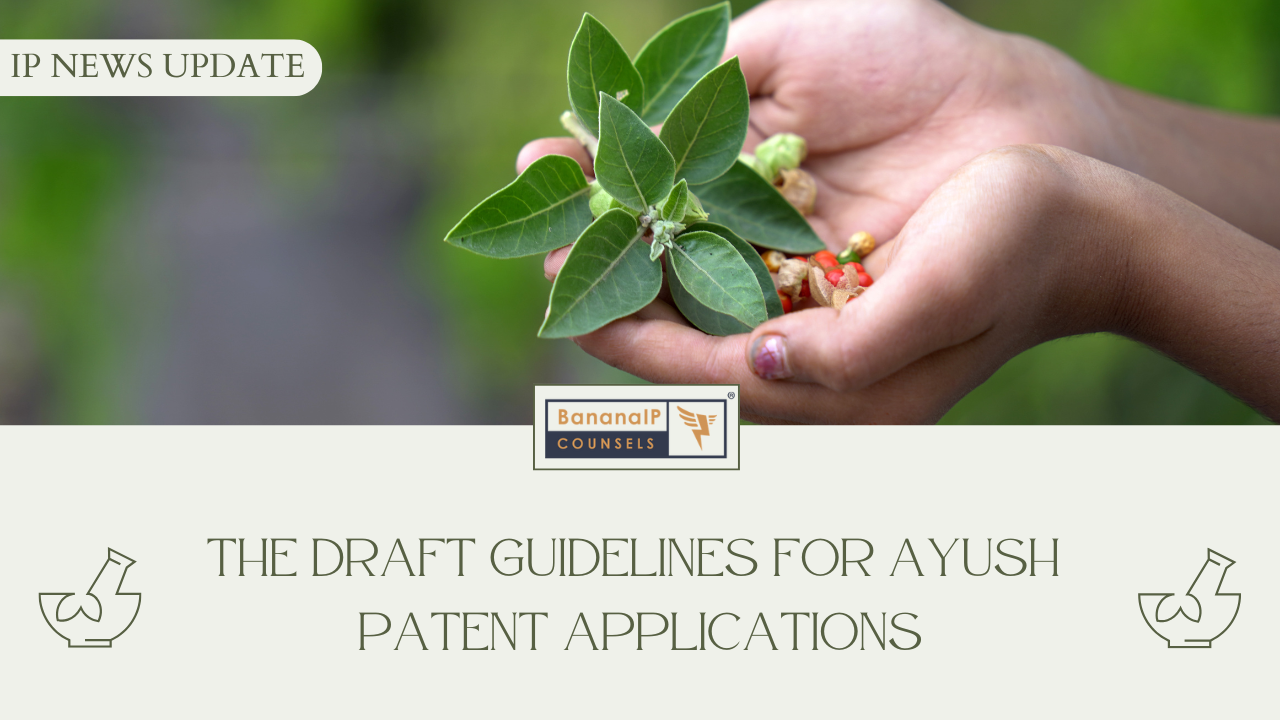Introduction
The Intellectual Property (IP) Office has issued Draft Guidelines for the processing of patent applications related to AYUSH systems and related inventions. These guidelines aim to streamline the evaluation process of patent applications concerning Ayurveda, Yoga & Naturopathy, Unani, Siddha, Sowa-Rigpa, and Homeopathy.
The proposed guidelines are intended to provide clarity on how patent applications in this domain may be assessed, particularly in light of provisions under the Patents Act, 1970, including Section 3(e), which deals with admixtures and combinations.
Stakeholders are invited to provide their comments and suggestions on these Draft Guidelines by 28th February 2025, which should be sent to Ms. Anita Jatav, Deputy Controller of Patents & Designs by email to anita.ipo@nic.in.
Scope and Key Considerations in the Proposed Guidelines
The draft guidelines outline certain principles that may be considered while evaluating patent applications in the AYUSH domain. Below is an overview of these proposed principles:
1. Extracts, Alkaloids, and Active Ingredients
The proposal suggests that claims related to plant extracts, alkaloids, or isolated active ingredients from plants already described in AYUSH systems may not be considered novel or inventive. However, patent protection may be considered for the process of extraction, provided it meets the criteria of novelty and an inventive step.
Example: A claim for an aqueous extract of Ashwagandha for stress relief may not be eligible if traditional literature already mentions this use. However, a new and innovative method of extraction could be considered.
2. Combinations of Known Ingredients
The draft guidelines propose that a combination of multiple known medicinal ingredients for a pre-existing therapeutic use may be considered obvious unless it demonstrates a synergistic effect—meaning the combination works better than the sum of individual effects.
Example: A composition containing Calendula, Aloe Vera, and Centella Asiatica for wound healing may not qualify for patentability unless it demonstrates an unexpectedly enhanced effect beyond individual components.
3. Known Ingredients in New Combinations
The proposal indicates that if an ingredient already known for treating a disease is combined with additional components for the same therapeutic effect, the combination may not qualify as inventive unless it exhibits unexpected benefits.
Example: A combination containing Cucumis melo extract for vitiligo treatment may not be considered inventive if Cucumis melo is already documented for this purpose in traditional knowledge.
4. Optimized Ratios of Known Ingredients
The proposed guidelines suggest that merely adjusting the proportion of known ingredients does not necessarily make an invention patentable, as optimizing ingredient ratios is a routine practice.
Example: A formulation containing Pongamia pinnata (2–20%), Lawsonia alba (5–15%), and Datura alba (2–20%) for ulcer treatment may not qualify as an invention if prior literature already documents these plants’ use for similar purposes.
5. Isolating a Single Component from a Known Mixture
If multiple plant-based ingredients are traditionally used for an ailment, extracting just one from the mixture and claiming in a patent application may not qualify the inventive step requirement unless it shows unexpected advantages.
Example: If Zingiber zerumbet (Bitter Ginger) is traditionally used for treating asthma, an extract of only Bitter Ginger for the same purpose may not be considered inventive.
6. AYUSH Equipment and Devices
Innovations related to devices or equipment used in AYUSH therapies may be eligible for patent protection if they demonstrate novelty and an inventive step.
Example: A modern, automated Vamana Karma (therapeutic emesis) device with sensors for pH, temperature, and volume monitoring may be considered for patent protection, as traditional Ayurveda does not describe such a device.
Section 3(e)
The Draft provides specific clarity on Section 3(e) (that excludes Admixtures from Patentability) relating to AYUSH patent applications. As per the draft guidelines, to demonstrate inventiveness, a combination should show an effect greater than the sum of its individual components in order to overcome Section 3(e) exclusion.
Examples:
- May be Patentable: A combination of Tamarind Seed Polysaccharide (TSP) and Helichrysum italicum extract, where research shows a significantly enhanced antimicrobial response beyond the sum of individual effects.
- May Not be Patentable: A mix of two anti-acne ingredients where no synergistic advantage is demonstrated.
- May be Patentable: An herbal anthelmintic formulation containing Trichosanthes dioica seeds and Prunus persica leaves, where testing indicates a significantly higher effect than the individual ingredients.
Call for Comments and Submission Details
The Intellectual Property Office invites feedback on the Draft Guidelines for Processing Patent Applications of AYUSH Systems and Related Inventions. Suggestions may be sent to Ms. Anita Jatav, Deputy Controller of Patents & Designs, at anita.ipo@nic.in by 28-02-2025.
Stakeholders, researchers, and industry experts are encouraged to review the document and share their inputs within the specified timeframe.
You may find the Draft Guidelines here:Draft guidelines for processing patent applications of AYUSH systems and related inventions



